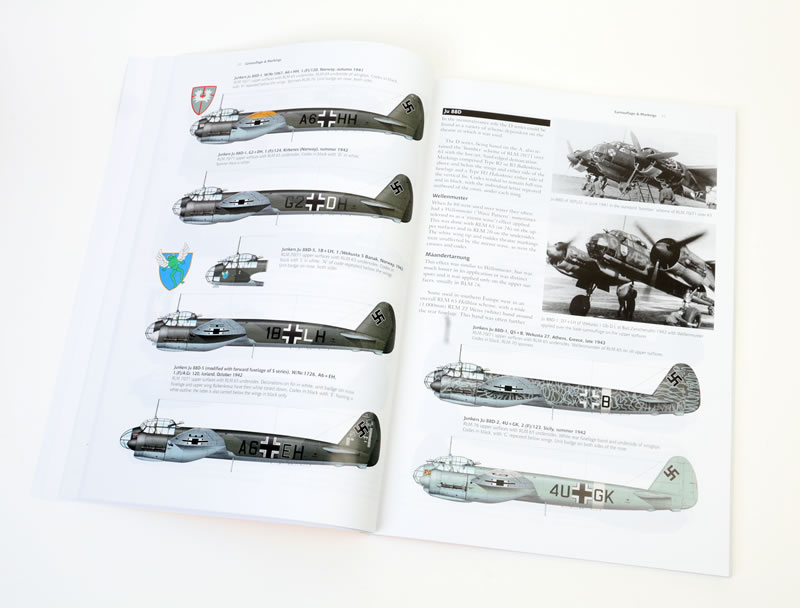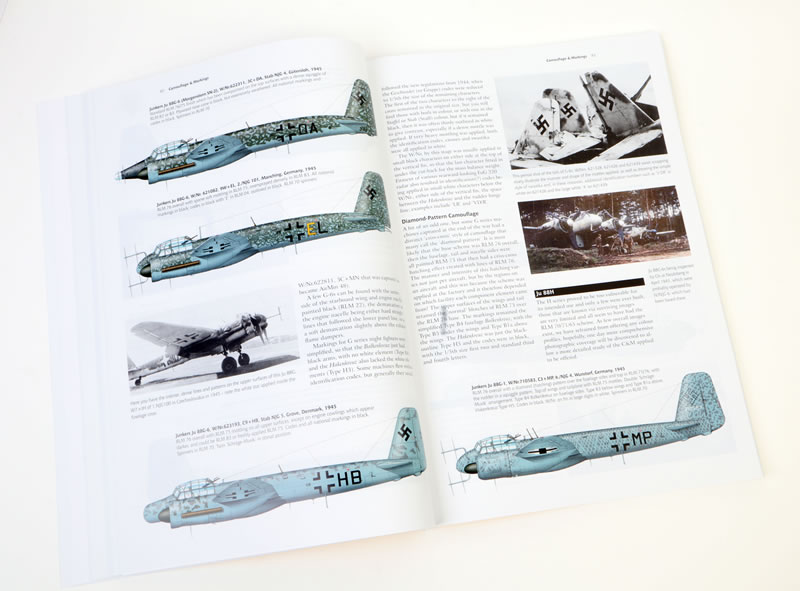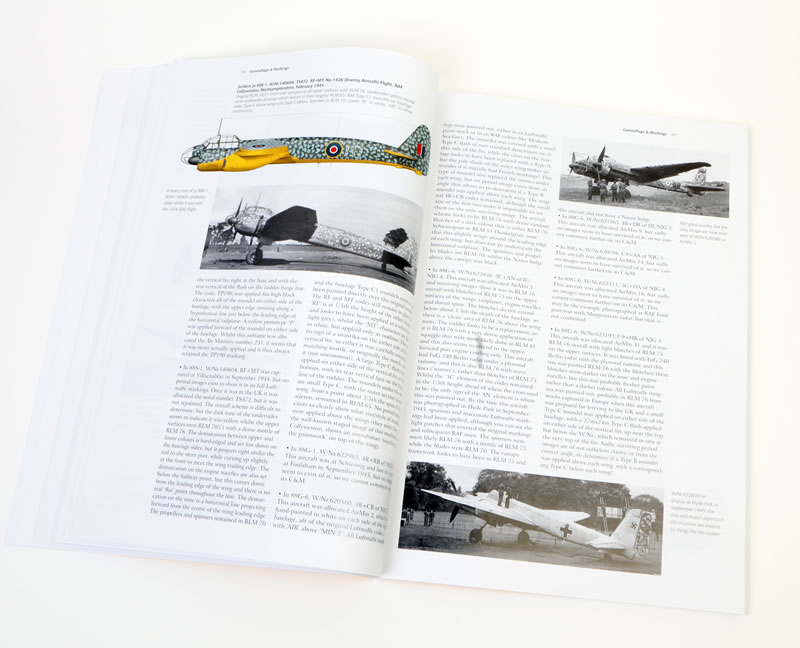The Junkers Ju 88
Part 2: Ju 88 C to Ju 88 T
by Richard A. Franks

Valiant Wings Publishing
Airframe and Miniatures No. 24
S u m m a r y |
| Publisher and Title: |
The Junkers Ju 88 Part 2: Ju 88 C to Ju 88 T
Airframe and Miniatures No. 24
by Richard A. Franks
Valiant Wings Publishing |
| ISBN: |
978-1-912932-31-3 |
| Media: |
256 pages in A4 portrait mode, many photographs and walkarounds, colour profiles, historical manual drawings, line drawings and model details. |
| Price: |
GBP£28.95 plus shipping available online from Valiant Wings
GBP£28.95 plus shipping available online from Hannants
and stockists worldwide. |
| Review Type: |
First Read |
| Advantages: |
Beautifully produced on quality paper, well bound so that it can be opened flat, masses of great information - photos, drawings and colour schemes - and good lists of all things a modeller needs to inspire the next masterpiece. |
| Disadvantages: |
None noted. |
| Conclusion: |
This really is an exceptionally useful follow-on volume that should be in every Luftwaffe modeller’s library, regardless of which scale one works in, or anyone with an interest in aviation history and technology. I recommend it wholeheartedly. |
Reviewed by Graham Carter

This is the latest in this popular series of modelling and technical books. It is the second volume treating the Junkers twin and befitting this widely-used and much produced aircraft this is a large edition, with 256 A4 pages, well bound with a glossy card cover and printed on quality glossy paper that allows excellent reproduction of images and drawings.
The cover is adorned with a Jerry Boucher commissioned illustration of a Ju88G-6 piloted by Oblt. Herbert Koch having just shot down a Halifax on 24th April 1945. The rear cover has some handy full-colour drawings of some of the unit badges carried on the Ju 88 series.

There is much to appeal to the historian and technically-minded person as well as the modeller, with builds by Steve A Evans in 1/48 and in 1/72 from Libor Jekl and Richard Franks himself, as well as a listing of available kits and accessories.
Following the familiar path, the volume begins with a Preface and introduction of some twenty-six pages covering the story of the development of the later series C to T variants of this Junkers twin, their usage by Hungary and Rumania, as well as the Luftwaffe, and France after the war. There is also information about captured examples in the hands of the RAF and USA. B&W photos illustrate most of these.

Chapters 1-3 are thirty-four pages of the Evolution of the various variants. Covered here are some of the one-offs and projected but unbuilt airframes as well. These changes are illustrated with port-side sketches and some images.
Next comes Chapter 4 of thirty-five pages of info on Camouflage and Markings which provides information and photos or colour drawings by Richard Caruana of the schemes worn by examples from most users. The early ones were in the RLM 70/71/65 splinter schemes but as the war progressed there appeared a large number of variations depending upon the theatre of operations. Some of these variants received the overall sand colours or in patches. Various pale splotches and squiggles adorned the night-fighter Ju88s in a vast array of schemes that have attracted the modeller for decades now.
Chapter 5 follows the earlier volume in that it is devoted to a round-up of available kits in the major scales. Each of the main available kits is described and an outline of any strengths or weaknesses is given. This will assist modellers to select the kit that best suits their skills and pockets.
There then follows Chapter 6, which covers two builds by Libor Jekl of the 1/72 Hasegawa G-6 variant, Richard Franks does the HobbyBoss Ju88, and then Steve A Evans with a 1/48 ICM C-6 with each of these builds being well-illustrated and written and do point out some ways to improve or tackle each kit.

Chapter 7 is thirty-six pages about ‘Building a Collection’ in which each variant from the Z-1 prototype through real and projected variants up to the T-3, is illustrated with an annotated sketch to point out the differences or special features of each, by Wojciech Sankowski. Some of these projects were certainly interesting, such as the long-fuselage variants. Again I would request that some of these should be underside drawings to illustrate important features that do not show up in the upper three-quarter views provided.
Then Chapter 8 covers the aircraft In Detail with over sixty pages containing sections on the engine, cockpit interiors, wings and control surfaces, undercarriage, armament, ordnance, electrical and radar, radios, ground equipment and miscellaneous bits and bobs. All of these are covered in some depth with clear detailed contemporary B&W photos, illustrations from service or technical manuals and some colour images of preserved aircraft. All photos have good captions and should be a boon for the super-detailer among modellers.
There are then four appendices covering alphabetic lists by scale, all of the kits that have been available, accessories, decals and a bibliography. At twelve closely spaced triple-columned pages a heck of a lot of work has gone into compiling these lists and I again commend the researchers for this task.
Inside the rear cover are the familiar scale drawings. In this case there are eight fold-out sheets showing a number of different variants in profile and then plan views of upper and lower surfaces, all in 1/48.
This really is a very useful volume that should be in every Luftwaffe modeller’s library, regardless of which scale one works in, and I recommend it wholeheartedly. It follows the earlier edition and brings together a great deal of information in a single volume and therein lies its usefulness. Hopefully, at some time, one on the Ju 188 and further projects. Certainly a magnum opus for modellers and historians alike!
Thanks to Valiant Wings Publishing for the sample.
Review Copyright © 2024 by Graham Carter
This Page Created on 3 October, 2024
Last updated
4 October, 2024
Back to HyperScale Main Page
Back to Reviews Page
|
